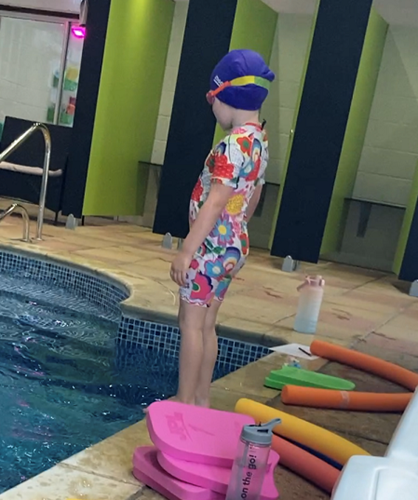Swimming lessons
Published Date: 27 Oct 2022
It’s Saturday morning. The hubbub of children joyfully splashing and shouting sends echoes bouncing across the huge watery abyss, known to most as a swimming pool.
As a hearing aid user, I’ve always been quite happy to skip that cacophony of noise that most people hear in the water. It’s always a bit of a shock putting my aid back in once in the changing rooms! My daughter, however, has the option of hearing in the water with her aqua kit for her cochlear implants. She thrives on hearing in the water, which she’s been able to do since the age of two when we tentatively tried it out for the first time, crossing our fingers we weren’t going to break the equipment!
We’ve always stuck with using one aqua ear at a time, just in case it ever went wrong. So whilst she has some hearing, it’s half of what she usually has and is partially muffled by the silicone casing over her processor. She still very much needs to rely on lipreading alongside it.
This brings us to swimming lessons. These take a little more consideration for us. Until early this year, Isabelle went to parent/child lessons, which meant Ross (her dad) could relay instructions directly to her. However, with 10 children and 10 adults in the pool, she was wildly distracted by noise, and the teacher was hard to follow because they were poolside.
When the time came to move up a stage, we decided to leave her Saturday swim school and enrol her in one-to-one swimming lessons elsewhere. Well, what a change! It’s only been a few weeks, but already she has progressed to swimming unaided and finally faced her fear of jumping in solo and putting her face in the water last week.
When she’s older, I suspect she’ll get a lot out of group lessons, but at the age of four, her attention is already easily diverted, and that’s before adding hearing loss into the mix, so this is the way forward for now.

There were initially a few teething problems. Her instructor hadn’t taught a deaf swimmer before and doesn’t sign. I shared a few tips, and they have taken these on board and learnt to adjust their usual position for lipreading, slow their speech and make use of a lot of visual cues. For example, in week 1, the instructor was standing behind Isabelle supporting her head. Whilst she’s a proficient lip-reader, doing so upside-down was beyond her means! A simple move to supporting from the side of the body was all the change needed. And if there are any real communication issues, I’m still poolside to sign if need be.
Swimming caps are compulsory, which has actually worked out in Isabelle’s favour. The aqua kit is tethered to her costume, but the swim cap helps ensure the processor and magnet stay in place even when jumping in.
I recognise it’s a real luxury to be able to send her to one-to-one lessons. It would be amazing if there were more options for deaf aware instructors or classes in our local area. Perhaps in the future. For now, though, our little Ariel is splashing her way to swimming success.
